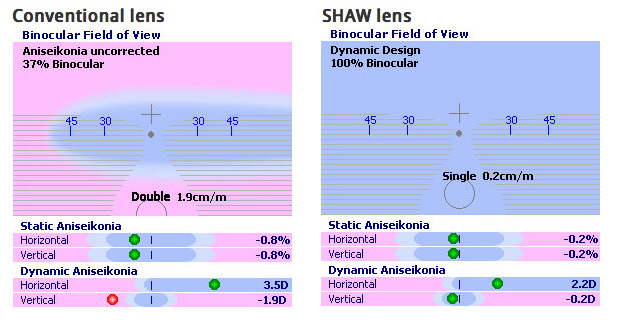Designing lenses that take into account how both eyes work together is not an easy task. The math is complex in a purely theoretically environment but when you factor in other variables like frame dimensions, the position of the glasses on an individual patient’s face and the limits that lens manufacturing and optics place, it’s no wonder why no one has done this before.
That’s what makes the SHAW lens unique. The SHAW lens process uses a patent-pending method to accurately model eye rotation in order to predict distortions caused by eye glasses. We then use that information to design a lens that reduces or eliminates the distortion other lenses can cause.
The key to making a SHAW lens is the measurement of Motor fusion (vergence) limits by the optometrist using Risley prisms on the phoroptor. It’s these tolerances that make all the difference.
The patent-pending SHAW™ lens is a digital lens system that revolutionizes how optometrists think about eyeglasses. It is the only truly binocular spectacle lens system. Using the SHAW lens design software, the clinician has direct control over management of both refractive and binocular components. The exact effect on the vision system can be readily analyzed, and benefits of a SHAW design is graphically displayed before the lens is ordered.

In the case of aniseikonia due to anisometropia and meridional anisometropia, lateral static aniseikonia is responsible for the inability to maintain sensory fusion. Dynamic aniseikonia is responsible for the inability to maintain motor fusion while reading.
The effect of base curvature (the curve of the lens) is not linear as the eyes rotate. The SHAW lens design software optimizes base curve using a complex iterative process. The software provides the best combination of lateral control and vertical dynamic correction to reduce both dynamic and static aniseikonia.
Even when there is no anisometropia, dynamic aniseikonia is often induced due to unequal prismatic effect. This can be the case with frames with a high degree of face form angle and prescribed prism.
The effect of a face form angle is to induce base in prism in lateral gaze with near-sightedness (the eyes are forced to diverge) and base out prism with far-sightedness (the eyes are forced to converge).
Prescribed prism (e.g., base up in one eye and base down in the other) will create an opposing curvature of image due to the nonlinearity of the prismatic effect; this is because of a differing optical path length caused by the prism, thus creating a pincushion effect at the prism apex.
Base curve optimization significantly improves these two conditions.
A third benefit of the SHAW lens design is the reduction of image compression in extreme gaze (>45 degrees).
This is particularly interesting on the golf course while putting. Dr. Shaw’s an avid golfer, and he found that the increase of base curve led to a dramatic improvement in his ability to line up the putt since there is less distortion of the green when he’s addressing the ball. (Coming soon from Shaw Lens Inc.: a lens designed especially for golfers!)
The SHAW lens design software allows the practitioner to design lenses using two difference methodologies:
The SHAW lens design software includes a size lens “calculator” in which the parameters of the habitual or trial frame prescription and the required size lens correction are combined into a final interocular magnification target.
The SHAW lens design software also uses face form angle, bridge vertex and axial length in order to establish the expected location of the centre of rotation relative to the spectacle lens position. Based upon the analysis of the resulting model, the software defines the base curvature, centre thickness, index of refraction and progressive lens geometry to correct the aniseikonia and reduce the induced anisophoria associated with anisometropia, meridional anisometropia, surgically induced aniseikonia, face form angle and prescribed prism.
The effect of base curvature is nonlinear. The SHAW lens design software takes this into account by using a ray tracing algorithm to optimize the base curvature.
You shouldn’t have to “get used” to your SHAW lenses. In fact, if you don’t think your SHAW lenses are the best you’ve worn from the minute you put them on – then we’ll make it right or give you a full refund. It’s that simple. Please make any claims within 90 days of receipt of lenses.